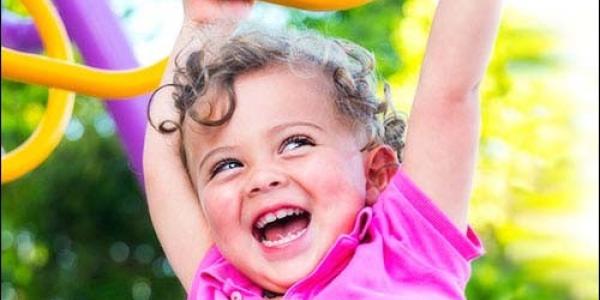Playing, Laughing, and Learning in Preschool

You are here
Squealing laughter erupts from beneath the loft. I peer in to see four children playing Pilgrims and Robbers, a game the children invented. It is dinnertime, but all they have to eat is a smelly opossum—“A robber trampled it with his horse.” The children are gathered around the opossum (a stuffed teddy bear), and Woody is pretending to carve it like a Thanksgiving turkey. He hands pieces of opossum to his friends and shouts, “Carrrrve that opossum!” The others shriek, squirming around on the floor as they clutch their bellies.
The children’s laugher was bellowing, contagious, and almost constant, and sometimes it bordered on uncontrollable. At one time I might have asked them to quiet down. However, once I decided to nurture children’s sense of humor, laughter was always a delightful and welcome sound in the classroom. Eventually I joined their scenario, bringing my plate and asking for an extra-rare piece of opossum with ketchup. Here are some ways to learn to let go of control and encourage laughter with preschoolers.
- Know the children’s interests. Learn about the books, music, movies, and television shows the children are interested in. Use the information to relate to the children and laugh with them. Considering children’s cultures, ethnicities, and backgrounds is also important. Children from different backgrounds often experience humor in different ways.
- Talk with preschoolers about laughter and humor. When the children laugh, ask them about what they find funny. Discussions about laughter help teachers discover children’s perspectives and understand what led to the laughter. As children become more aware of their laughter, they will see it as something desirable that they want to repeat.
- Use laughter to help children build relationships. Laughter often brings people closer, helps them communicate, and creates a shared experience and common bond. An environment filled with laughter strengthens the relationships of teachers with children and of children with each other.
- Share silly books and stories. Story time is a chance to read books that tickle children’s funny bones. Preschoolers often enjoy books with rhymes, silly sounds, and made-up or nonsense words. Older preschoolers might also laugh at characters who make mistakes or get into trouble. They love it when the teacher uses a different voice for each character, makes funny sounds or faces, and invites the children to join in the story.
- Involve the whole body. Children laugh when adults jump, dance, sing, and use their whole bodies. Do a silly walk, sing a funny song, or invent a little dance with them during transitions. In addition, when children laugh, they’re more likely to remember what they learn.
- Try something new. This is the surest formula for success! Children often laugh when something unexpected happens. Activities that challenge what children know and expect are sure to produce laughter. Set up a new learning center, try a fresh activity, read a new book, take a field trip, and invite a human or animal guest to the classroom.
- Set children up for success. Children often laugh with pleasure when they master something new. A child who learns to pump her legs to propel the swing on her own might screech with laughter when she succeeds. Experiences like this build confidence, competence, and feelings of success.
- Break the taboo: Body sounds and other noises. To close, I must mention the unmentionable—body sounds. Are they funny? Disgusting? Intolerable? Most teachers shut down this kind of humor, but there is certainly a time and a place to laugh about these things. Recall when you were a child and found such noises hilarious. Learn to accept that laughter at passing gas, burping, and mouth sounds is part of childhood, and humor will follow.
Photo © iStock
Sarah Smidl is an assistant professor of occupational therapy at Radford University, in Radford, Virginia. She has worked with children of all ages and abilities for almost 20 years. Her article “My Daddy Wears Plucky, Ducky Underwear: Discovering the Meanings of Laughter in a Preschool Classroom” was published in the June 2014 issue of Voices of Practitioners, NAEYC’s online teacher reseach journal.